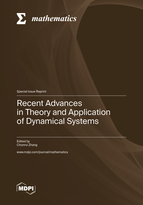Recent Advances in Theory and Application of Dynamical Systems
A special issue of Mathematics (ISSN 2227-7390). This special issue belongs to the section "Dynamical Systems".
Deadline for manuscript submissions: closed (31 March 2023) | Viewed by 17711
Special Issue Editor
Interests: functional differential equations (bifurcation theory and numerical analysis); partial differential equations (parabolic type); mathematical biology (forestry resource modeling; spatiotemporal pattern formation)
Special Issue Information
Dear Colleagues,
Using functional analysis, topological and algebraic approach to study dynamic systems has become more and more important in the dynamic systems theory and has drew a great interest to many researchers recently. On the other hand, modeling with dynamic systems have been widely used to describe the dynamical behaviors in almost all areas of science and engineering. This Special Issue invites papers on innovative proposals of theory and application of dynamical systems. This proposal aims to publish results of recent developments in Dynamical Systems, and new applications to engineering, physics, medicine, and economics.
Potential topics include but are not limited to:
- New theories in dynamic systems;
- Qualitative behaviors of dynamic systems;
- Dynamics properties include stability, bifurcation, and chaos;
- Numerical methods for dynamic systems;
- Simulation analytics in dynamic systems;
- New modeling and technology for dynamic systems in science and engineering.
Prof. Dr. Chunrui Zhang
Guest Editor
Manuscript Submission Information
Manuscripts should be submitted online at www.mdpi.com by registering and logging in to this website. Once you are registered, click here to go to the submission form. Manuscripts can be submitted until the deadline. All submissions that pass pre-check are peer-reviewed. Accepted papers will be published continuously in the journal (as soon as accepted) and will be listed together on the special issue website. Research articles, review articles as well as short communications are invited. For planned papers, a title and short abstract (about 100 words) can be sent to the Editorial Office for announcement on this website.
Submitted manuscripts should not have been published previously, nor be under consideration for publication elsewhere (except conference proceedings papers). All manuscripts are thoroughly refereed through a single-blind peer-review process. A guide for authors and other relevant information for submission of manuscripts is available on the Instructions for Authors page. Mathematics is an international peer-reviewed open access semimonthly journal published by MDPI.
Please visit the Instructions for Authors page before submitting a manuscript. The Article Processing Charge (APC) for publication in this open access journal is 2600 CHF (Swiss Francs). Submitted papers should be well formatted and use good English. Authors may use MDPI's English editing service prior to publication or during author revisions.
Keywords
- new theories in dynamic systems
- qualitative behaviors of dynamic systems
- dynamics properties include stability, bifurcation, and chaos
- numerical methods for dynamic systems
- simulation analytics in dynamic systems
- new modeling and technology for dynamic systems in science and engineering






